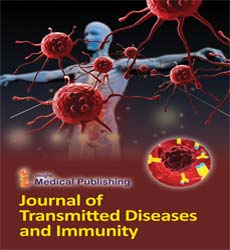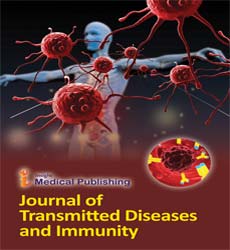ISSN : 2573-0320
Journal of Transmitted Diseases and Immunity
Chlamydia Trachomatis Genital Infections: Parade
Ranjan Das*
Department of Clinical Sciences,College of Medicine, University of Sharjah, Sharjah, United Arab Emirates.
- *Corresponding Author:
- Ranjan Das
Department of Clinical Sciences,College of Medicine, University of Sharjah, Sharjah, United Arab Emirates.
E-mail: ranjandedu@gmail.com
Received Date: March 08, 2021; Accepted Date: March 19, 2021; Published Date: March 29, 2021
Citation:Das R (2021) Chlamydia Trachomatis Genital Infections: Parade. J Transm Dis Immun. Vol.5 No.2:33
Chlamydia may be a sexually transmitted communicable disease caused by the bacterium Chlamydia trachomatis. Within the US, it's the foremost commonly reported bacterial infection.
In females, the cervix is that the anatomic site that's most ordinarily infected. This will manifest as cervicitis, urethritis, pelvic disease, perihepatitis, or proctitis. Chlamydial infections in women, especially if untreated, increase the danger of infertility and extrauterine pregnancy, resulting in high medical costs. There also are risks if a lady has an infection during pregnancy.
In men, infection with Chlamydia trachomatis can cause urethritis, epididymitis, prostatitis, proctitis, or reactive arthritis. Both men and ladies infected with C. trachomatis can also experience conjunctivitis, pharyngitis, and LGV. LGV, caused by distinct serovars of Chlamydia trachomatis, may be a less common disease characterized by enlarged lymph nodes or severe proctocolitis.
Most persons with this infection are asymptomatic. Untreated infection may result in serious complications like pelvic disease, infertility, and extrauterine pregnancy in women, and epididymitis and orchitis in men.
In women, the bacteria initially infect the cervix, where the infection may cause signs and symptoms of cervicitis [e.g., mucopurulent endocervical discharge, easily induced endocervical bleeding], and sometimes the urethra, which can end in signs and symptoms of urethritis [e.g., pyuria, dysuria, urinary frequency].
Chlamydia trachomatis is one among several species within the genus Chlamydia that cause human disease, but it's the sole one that only infects humans. Chlamydiae are obligate intracellular bacteria that can't be cultured on artificial media. Susceptible cell culture systems are needed to grow them within the laboratory. Chlamydiae are distinguishable from all other organisms by a singular developmental cycle which involves transition between 2 major morphologic forms. The infectious particle, called the elementary body [EB], attaches to susceptible host cells and is ingested by a process like receptor mediated endocytosis. Chlamydia are often easily treated with a brief course of antibiotics. You’ll be ready to take all the antibiotics in at some point, or over every week, counting on the sort of treatment prescribed.
It’s important to not roll in the hay until you and your current sexual partner/s have finished treatment. If you’ve had the oneday course of treatment, you ought to avoid having sex for seven days afterwards. Ask your healthcare professional when it’s safe to possess sex again.
Remember that if you’ve been treated for chlamydia you're not immune and you'll get infected again. A person can’t become immune to chlamydia albeit treated; they will be effected again with it.

Open Access Journals
- Aquaculture & Veterinary Science
- Chemistry & Chemical Sciences
- Clinical Sciences
- Engineering
- General Science
- Genetics & Molecular Biology
- Health Care & Nursing
- Immunology & Microbiology
- Materials Science
- Mathematics & Physics
- Medical Sciences
- Neurology & Psychiatry
- Oncology & Cancer Science
- Pharmaceutical Sciences
